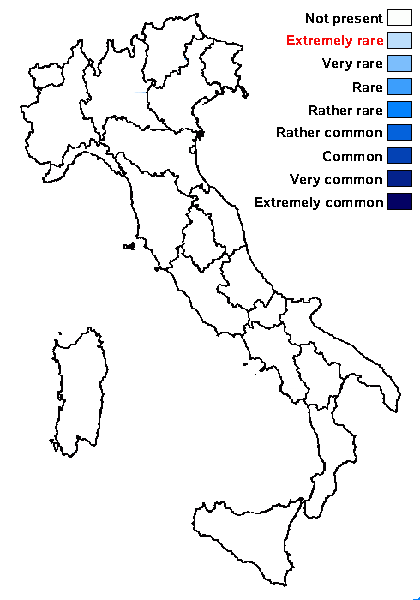Rhizocarpon kakurgon Poelt
Mitt. bot. Staats. München, 3: 573, 1960.
Synonyms:
Distribution:
Description: Thallus crustose, episubstratic, sulphur yellow, forming 2-10 mm wide patches on the thalli of Aspicilia-species (e.g. A. candida, A. mashiginensis), without a distinct prothallus. Areoles contiguous, 0.5-0.8 mm wide, angular, flat to slightly convex. Apothecia lecideine, black, rounded to angular, 0.5-1 mm across, with a flat to convex disc and a poorly evident proper margin. Proper exciple thin, brown-black, K+ purple-red (solution); epithecium brown, K+ purple; hymenium colourless, 120-160 µm high; paraphysoids coherent, branched and anastomosing; hypothecium brown-black. Asci 8-spored, clavate, fissitunicate, with a well-developed tholus, lacking an ocular chamber, Rhizocarpon-type. Ascospores submuriform, with 2-6(-8) cells in optical view, dark brown, subglobose, 10-17(-20) x 8-11 μm. Photobiont chlorococcoid. Spot tests; K-, C-, KC-, P-. Chemistry: rhizocarpic acid.Note: an arctic-alpine(-nival) species found on hard calcareous schists, obligately parasitic on Aspicilia-species (e.g. A. candida, A. mashiginensis); most records are from the Alps but the species was also reported from Greenland. Not yet reported from Italy, to be looked for in the Alps.
Growth form: Crustose
Substrata: rocks
Photobiont: green algae other than Trentepohlia
Reproductive strategy: mainly sexual
paras Aspicilioid lichens

Predictive model
Growth form: Crustose
Substrata: rocks
Photobiont: green algae other than Trentepohlia
Reproductive strategy: mainly sexual
paras Aspicilioid lichens

Predictive model
 Index Fungorum
Index Fungorum
 GBIF
GBIF

